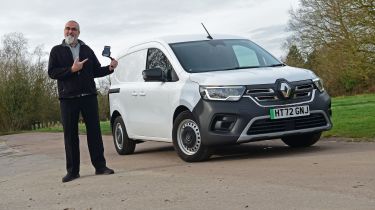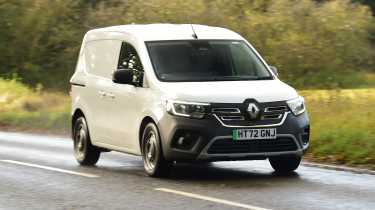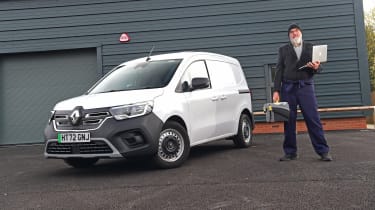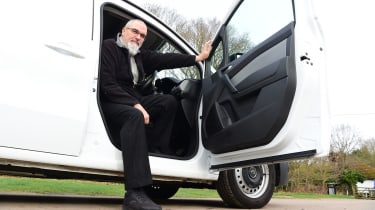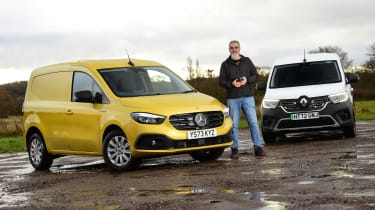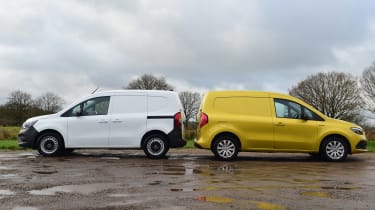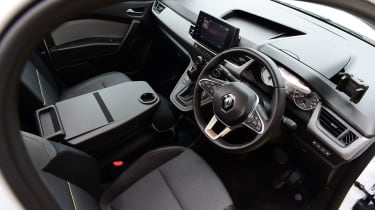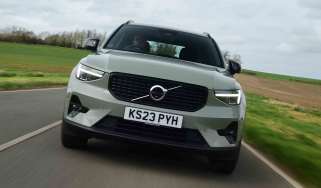Renault Kangoo E-Tech long-term test: a surprisingly sophisticated small electric van
Final report: frustrating infotainment hasn’t spoiled our time with electric van
Verdict
The latest Kangoo E-Tech is a great van that’s quiet and responsive, making it ideal for urban use, but the touchscreen issues left us wondering if such tech is necessary in a work vehicle where reliability is key.
- Mileage: 7,483
- Efficiency: 3.1 miles/kWh
Connectivity is a wonderful thing when it works properly. But if it fails, it can be hugely frustrating and leave you wondering what’s the point of it at all. That’s what I’ve been asking myself after a few too many issues with the tech on board our Renault Kangoo van.
Incorporating smartphone compatibility with the latest touchscreen tech is a great innovation that means even the most
basic cars can now come with navigation. The Kangoo’s eight-inch Easy Link system doesn’t feature nav, but you can plug your phone into the USB socket on the front of the touchscreen to activate Apple CarPlay (or Android Auto, if that’s your operating system).
That’s the theory, anyway. While the Kangoo’s system does activate and operate via the screen to start with, there have been too many times where the connection has failed, and not for any obvious reason. When it does give up, all that happens is the screen switches from CarPlay back to the Renault display, with no notification of a disconnection occurring. I’ve tried different leads and different phones, but the same thing keeps happening.
Used - available now

2018 Mercedes
C-Class Cabriolet
36,850 milesAutomaticDiesel2.1L
Cash £17,150
2021 Vauxhall
Corsa
75,747 milesManualPetrol1.2L
Cash £7,500
2024 Kia
XCeed
18,041 milesManualPetrol1.5L
Cash £15,950
2022 Mazda
MX-5
16,971 milesManualPetrol1.5L
Cash £16,100I have noticed that turning the van off and back on again after a brief period increases the chances of a disconnection happening. On the other hand, while unplugging the lead from the USB socket and re-inserting reactivates CarPlay, the chances of it shutting down again are increased. It’s mystifying as to why it happens – it’s not as if my device is overheating or anything like that – and invariably it occurs when I need it the most, usually when trying to navigate to an unfamiliar destination and often when approaching a busy junction.
There is an alternative, though. Our Kangoo came with an optional smartphone dock, a handy £20 bracket that clips into one of two housings on either side of the instrument binnacle and puts your phone in a prominent position on the dash. If you’ve got a newer device with a large screen, then you’ll have no problem using it and bypassing Easy Link completely. Plus you’ll have a higher-resolution screen than the Renault’s built-in display.
Aside from the screen issues, life with the Kangoo E-Tech has been about as easy and hassle-free as can be. It’s only really been used for short, local journeys, so a range of around 135 miles from a full charge has been plenty, while the large cargo area (for a small van) has taken everything in its stride.
One aspect of the Kangoo that has been particularly enjoyable is the effortless performance it offers. The electric motor’s low-down punch and smooth delivery mean the Renault is quite sprightly off the line – it’s night and day when compared with the sluggish combustion-engined versions – and is a surprising contender at the traffic-light grand prix.
Unfortunately our time with the Kangoo has now come to an end. I’m going to miss its user friendliness (touchscreen excepted) and the neat on-board tech that simply made van life as easy as could be.
Renault Kangoo E-Tech: third report
Our Kangoo's workmanlike exterior hides a van that’s ready for business
- Mileage: 7,369
- Efficiency: 3.0 miles/kWh
There’s a saying that goes ‘dress for the job you want, not the job you’ve got’, and if you apply it to our Renault Kangoo, it clearly has ideas above its station.
From the outside it’s pure white van, with its black plastic bumpers ready to shrug off any knocks that might come their way. But climb aboard, and there’s an air of business-class quality about the cabin that belies the utilitarian exterior.
First, there’s the upholstery, which is hard-wearing, but has a bit of style to it, courtesy of the two-tone black and grey finish and bright-yellow piping. The drive selector is good to hold, while the switchgear has an upmarket feel.
In fact, the Kangoo uses the same trick as Renault’s sister firm Dacia, by borrowing kit from other models to help boost its upmarket appeal. The climate controls, for example, are the same as you’ll find in the Clio supermini, and the metal bezels they come with feel upmarket to the touch.
The fact that the Kangoo has climate control at all is another premium feature, considering that most vans of this sort often make do with a conventional thermostatic air-conditioning system.
Our van has a bunch of options fitted that only help with the high-end feel. Leather trim for the steering wheel is a £60 add-on, but it means the rim feels plush in your hands, rather than you making do with a cheaper plastic item. We’ve mentioned it in previous reports, but the digital rear-view mirror (£600) is also another great extra. With a plastic bulkhead behind you, it’s an option that complements the door mirrors, while the camera that feeds images to the screen never gets dirty, thanks to its roof-mounted housing.
This camera is no use for reversing because of the large blind spot immediately behind the van, but a separate back-up camera (£375) has you covered. Unfortunately this has a more conventional mounting position just above the number plate, so it can be obscured by dirt at this time of year.
Other upmarket features on board the Kangoo boost its safety, although some of the kit is a touch over-sensitive. The Active Emergency Brake system (£540) uses radar sensors to warn you of a potential forward collision, but more often than not it just flags up false warnings.
If you’re negotiating a narrow, twisty road with cars parked on either side, the set-up can occasionally think you’re about to collide with another vehicle, flashing a red warning between the dials and emitting a long beep. It can be frustrating, but at least it shows the system is working, and the Kangoo is far from the only vehicle I’ve driven that suffers from this.
Another gripe with the tech on board applies to the touchscreen, and its inability to stay connected to my smartphone. Apple CarPlay compatibility is included, while a USB socket on the front of the display means it’s easy to connect up, but the system randomly rejects my phone when it’s being used – usually at a time when I need it for directions. Simply unplugging the phone and reconnecting clears the fault, but then it seems quicker to disconnect my phone the next time it does it.
It’s the biggest gripe I have with the Kangoo, because otherwise it delivers a pretty decent drive, and one that’s very un-van-like in character. The electric motor isn’t the most powerful unit around, but it still has enough torque for the Kangoo to be surprisingly quick off the line, while the smooth and quiet power delivery contributes to the cabin’s refined feel.
And with the temperatures starting to warm again as we approach spring, the van’s range has taken a turn for the better, with 140 miles easily achievable on a full charge.
Renault Kangoo E-Tech: second report
Our van goes head-to-head with Mercedes’ parts-sharing eCitan
- Mileage: 6,667
- Efficiency: 2.9 miles/kWh
“That’s not a Renault Kangoo!” I hear you cry. And you’d be right. No, we haven’t lost our minds, because our rather plain Kangoo is lurking behind the vivid Limonite Yellow eCitan in our main image.
Admittedly the Kangoo isn’t quite as invisible as we’re making out, but we have good reason for bringing these two together, because they share the same bodyshell and running gear. We don’t do many van twin tests, so we thought a brief comparison here was worthy of inclusion.
Unlike some rivals, Renault and Mercedes have managed to make their vans stand out from each other. For the Kangoo, the look is inspired by Renault’s other vans, while the C-shaped running lights are carried over from its passenger cars. The eCitan has a traditional three-pointed star on the grille and separate small light units on either side, plus a wide grille across the front bumper – not that airflow is needed for the electric motor.
Of course, where the eCitan steals an advantage is with its optional yellow paint, while the top-spec Premium model has 16-inch alloys for a sharper look – although we appreciate the function over form that the Kangoo’s steel wheels provide.
It’s inside where the big differences really lie, because Renault and Mercedes have gone their own way in terms of cabin layout. For the Kangoo, it’s business first, with hard-wearing fabrics and plenty of rough plastics on show, while the touchscreen seems a couple of generations behind the tech available in Renault’s passenger cars. The other disappointment we’ve had with our Kangoo’s screen is its inability to hold on to an Apple CarPlay connection, because it has a tendency to drop out at random points.
For the Mercedes, there are circular air vents in the style of those found in its passenger cars, while the touchscreen is small but features the firm’s MBUX set-up. Combine this with a multifunction steering wheel featuring touch-sensitive controls, and the links between the Mercedes van and passenger car divisions become perfectly clear.
Both vans have their charging sockets in the nose behind their large badges, and that’s the first clue to their identical underpinnings. Power for the pair comes from a 120bhp electric motor connected to a 45kWh battery, but while Renault quotes a range of up to 186 miles for the Kangoo, Mercedes claims the eCitan can cover 176 miles under test conditions.
Cold weather means we’re not getting anywhere near those figures, with the Kangoo offering around 130 miles but dipping as low as 100 miles in freezing temperatures, and that’s with an energy-saving heat pump helping to take the
strain off the drive battery.
On the road, these two feel identical, so there’s instant torque and snappy responses at low speeds, while both vans are surprisingly quiet and refined when you consider that they’re designed for commercial use ahead of anything else.
So how about price? Well it might not be a surprise that the Mercedes badge adds a premium, with the eCitan costing £40,664 compared with £37,075 for the Renault, after factoring in the £2,500 Plug-in Van Grant. However, this is for the top-spec trim, which has kit such as a heated windscreen, seats and steering wheel, while the first four services are thrown in. What you can’t get are the Kangoo’s overhead storage shelves or twin passenger seat. Yes the latter is cramped, but it does add some versatility.
Renault Kangoo E-Tech: first report
We’re trying to make the numbers add up in our new electric van
- Mileage: 5,923
- Efficiency: 3.2 miles/kWh
If you’ve always driven petrol and diesel cars and vans, then you’ve probably got a pretty good gauge on how efficient an engine is. Over 40mpg for a petrol car is decent, more than 60mpg for a diesel is becoming the norm. But what about EVs?
With miles per gallon thrown out of the window, I’ll have to admit that it’s taken me time to learn how to judge whether an EV powertrain delivers good efficiency or not. I think I’m getting the hang of it now, and I’m currently being helped to understand miles per kilowatt hour with the latest arrival on our fleet, a Kangoo E-Tech.
The Renault scooped our Van of the Year title at the 2023 New Car Awards, and it was helped to overall victory thanks to the fact this second-generation electric variant has been available from launch.
As before, the Kangoo E-Tech features the same running gear as the Zoe electric supermini, so what you’re getting is a tried and tested EV system. There’s a 45kWh battery, which isn’t the biggest on offer in the class, but a WLTP-tested range of 186 miles is 12 miles longer than you’ll get in a Citroen e-Berlingo, for example. However, a revised Berlingo is on the way, and this should improve on those numbers.
Of course, this just tells you how far you’ll go with a fully charged battery, and as with the WLTP test for combustion-engined cars, your own results may vary. For electric vehicles, there’s no standardised economy figure just yet, and while the vast majority of manufacturers quote figures in miles per kilowatt-hour (mi/kWh), Renault doesn’t publish such a number for the Kangoo. Its trip computer does display it, though, and at the moment we’re hitting 3.9mi/kWh.
That’s a pretty good return, and is largely helped by the fact the Kangoo currently only does short local trips at speeds below 40mph, which is where EVs are usually shown in their best light. A quick calculation says that this equates to a real-world range of 176 miles, so only 10 miles short of the official figure, which is pretty good.
However, the trip computer’s range predictor says a full charge yields around 150 miles. At the moment we’re playing it safe and topping up little and often, rather than letting the battery run down until it’s ‘on fumes’, so to speak. But one day we might try to see which figure is correct.
We’ll have to watch how well the Kangoo holds on to that figure over the next six months, because cold weather often has an impact on EV range. However, this latest version gets a heat pump as standard, so where older models could see 10-12 miles trimmed from the total when the cabin heater is turned on, that’s not the case here.
As well as this pump, our Kangoo Advance also features air-conditioning, LED lighting for the cargo area, rear parking sensors, an eight-inch touchscreen and an electric handbrake. The latter automatically engages every time you put the van into Park, so there’s no secondary lever or button to engage.
On top of this, our van has been kitted out with some choice extras that make life easier for the driver. One highlight is Rear View Assist. This £600 system is a substitute for a rear-view mirror and it provides a clear view behind, also working well at night, as long as there are street lights. Another neat touch is the double passenger seat, which features a folding backrest that doubles as a table, while adaptive cruise control will help keep our economy figures consistent.
As standard, the Kangoo just gets a driver’s airbag, but kit such as lane assist, active emergency braking and blind-spot detection are all added to our van. It’s a shame that this kind of safety equipment, which is becoming standard on passenger cars, is still only on the extras list, but it will make its way across in time.
We’ve barely scratched the surface of the van’s ability so far, but it’s comfortable to drive. The instant power of the electric motor means it’s sprightly off the line, although it soon runs out of steam the faster you go, and it’s worrying to see the range figure drop a mile or so each time you accelerate. We’ll be doing plenty more to put its range claims to the test over the coming months.
| Price: | £37,075 (excluding VAT, after £5,000 grant) |
| Powertrain: | 1x e-motor, 118bhp, 45kWh battery |
| CO2/tax: | 0g/km/£0 |
| Options: | Active Emergency Brake (£540), Advanced Lane Assist (£660), Blind Spot Intervention (£420), tyre pressure monitors (£120), wooden flooring and side panels (£600), rear camera (£375), Rear View Assist (£600), leather steering wheel (£60), keyless entry (£150), smartphone dock (£20), adaptive cruise (£400) |
| Insurance Group: | 34 |
| Mileage: | 7,483 |
| Efficiency: | 3.1 miles/kWh |
| Any problems? | Glitchy infotainment system |
*Insurance quote from AA (0800 107 0680) for a 42-year-old in Banbury, Oxon, with three points.

